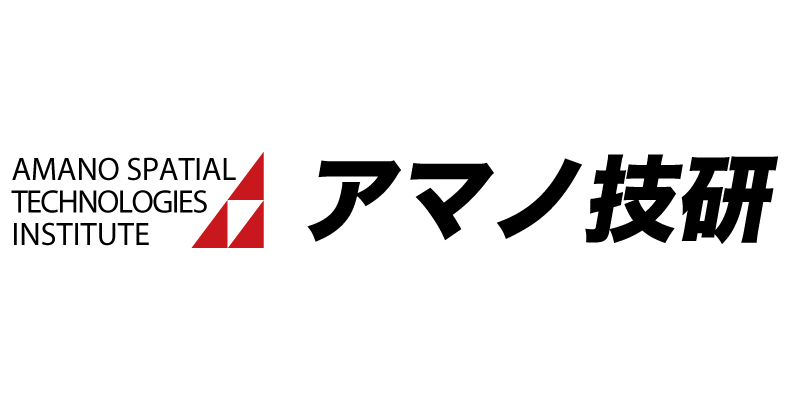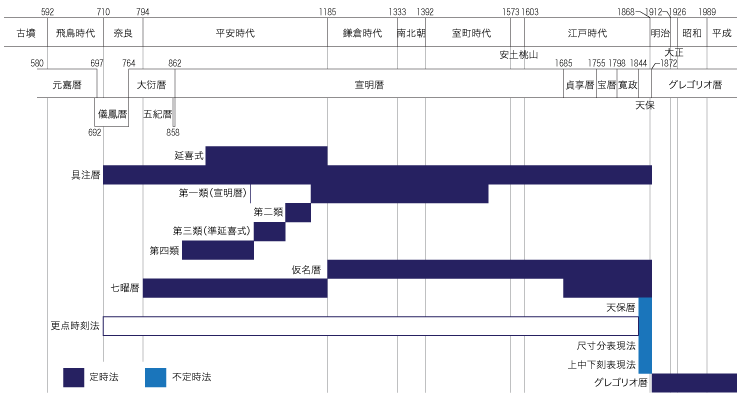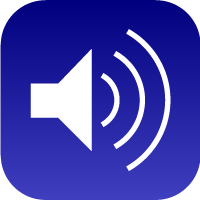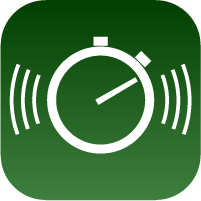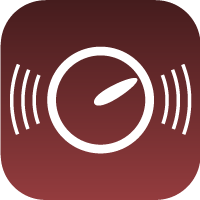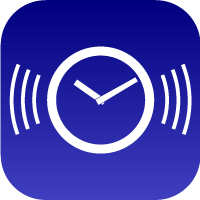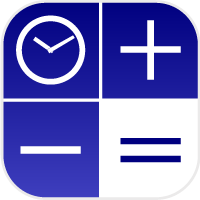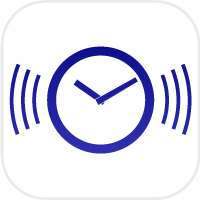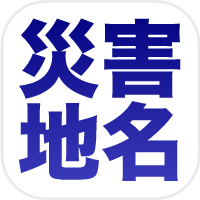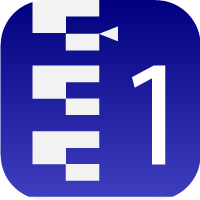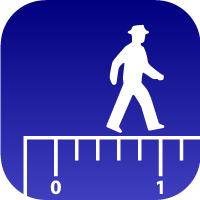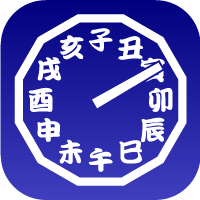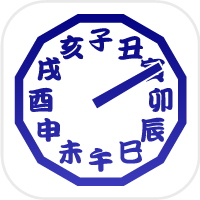
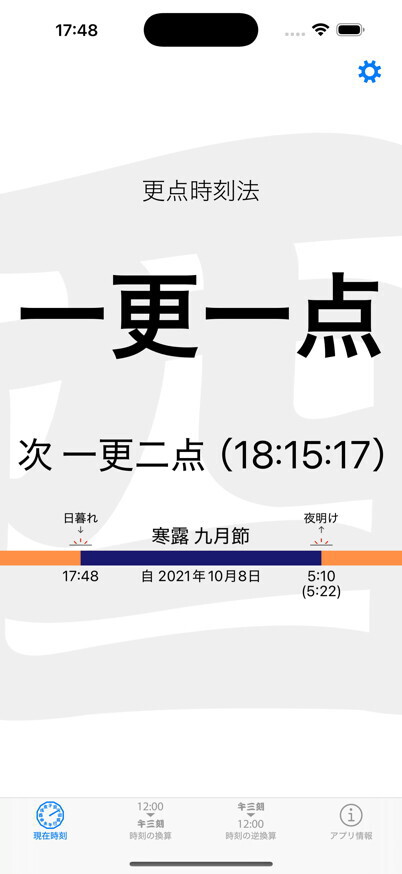
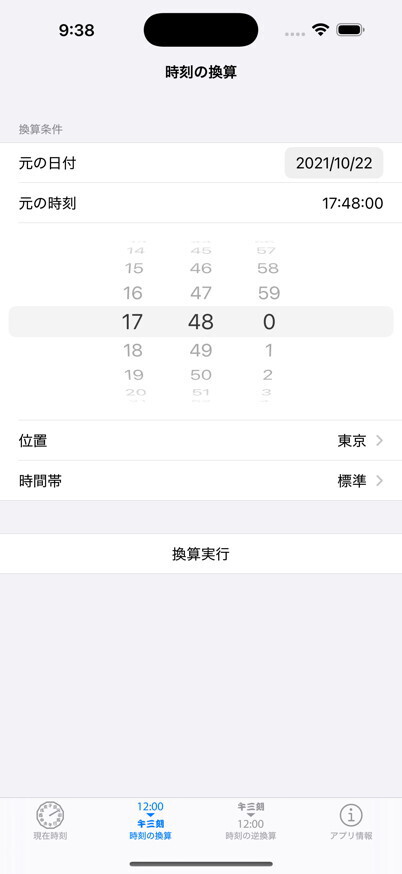
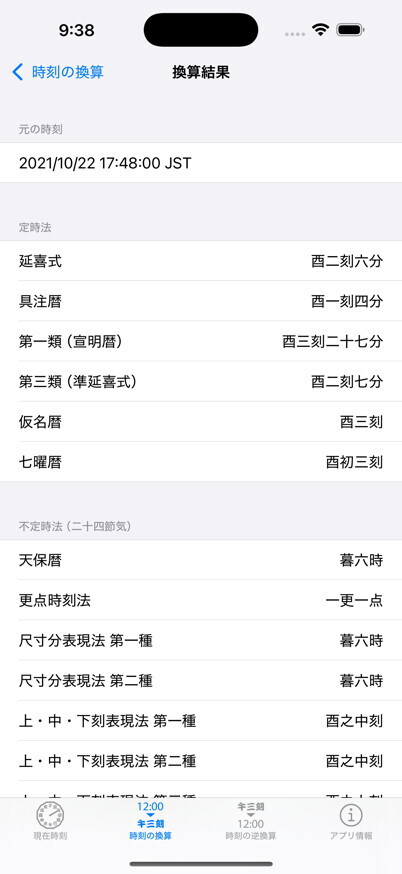
アプリ概要
本アプリは日本で過去に使われていた時刻制度を用いて時刻の表示を行うアプリです。使用可能な時刻制度は奈良時代から江戸時代にかけて使用された13種類を用意しています。定時法として延喜式,具注暦,第一類(宣明暦),第三類(延喜式に準ずる制度),仮名暦,七曜暦の6種類が利用可能です。江戸時代の天保以降で使用された不定時法として天保暦,尺寸分表現法(第一・二種),更点時刻法,上・中・下刻表現法(第一・二・三種)の7種類を用意しています。現在時刻の表示のほか,指定時刻の換算や,任意の時刻制度からの逆換算も可能です。
古文書の解読時や和時計の調整など,旧時刻制度での時刻換算が必要なときや江戸時代以前の生活をシミュレートしたい場合などにご利用ください。たとえば,「丑三つ時」なら平安時代の呪術を起源とするなら延喜式の「丑三刻」,現在時刻で午前2時に換算されます。時刻の読み方がわからないときは,表示時刻をタップすると時刻が読み上げられますのでご活用ください。
本アプリから天保暦のみ使用できるようにした機能限定版の「和時計・天保暦」もリリース中です。時刻の換算・逆換算機能は搭載していませんが,本アプリのご購入時のご参考にしてください。
他の時刻制度について,たとえば第二類(1096年〜1149年ごろに使用),第四類(877年〜1027年ごろに使用)などは文献の不足から現在の時刻との対応が完全にはとれないため未収録となっています。時刻制度の追加をご希望の方は,お問い合わせの際に時刻の対応を定義できる文献もあわせてお知らせください。ちなみに,本アプリは既存の和時計アプリの夜明け・日暮れの定義が日の出・日の入りになっていたり,京(京都)および中緯度地域でのみ適用可能な日の出の36分前,日の入りの36分後(36分は百刻制の2.5刻)を採用するものばかりであったため,より正しいものを提供しようということで開発したアプリになります。他の和時計アプリをご利用される場合も,明け六つは日の出の時刻ではない点,暮れ六つは日の入り時刻ではない点に注意して選択・利用いただけければと思います。
定時法
時間を刻む間隔が常に一定となる時刻法です。現在の日本は明治改暦以降,定時法のグレゴリオ暦に付随する時刻制度(1日24時,1時が60分,1分が60秒)を使用しています。各時刻制度の概要は以下のとおりです。西暦を除き漢数字は当時の時間・時刻,アラビア数字は現在の時間・時刻を表しています。
| 延喜式 | 四十八刻制。一日十二辰刻,一辰刻が四刻(一刻開始),一刻が十分(零分開始),一分が現在の3分。子三刻が現在の午後12時。 平安時代の延長5年(927年)に藤原時平ら(時平死後は藤原忠平)により編纂された『延喜式』(律令の施行細則)に付随する時刻制度。読みは「えんぎしき」。 |
|---|---|
| 具注暦 | 五十刻制。一日十二辰刻,一辰刻が四刻一分(初刻開始),一刻が六分(初刻は五と二分の一分,四刻は一と二分の一分),一分が現在の4分48秒。子二刻一分が現在の午後12時(午前0時)。 奈良時代から明治5年(1872年)の改暦まで使用された具注暦(漢文の暦本)に付随する時刻制度。本アプリは藤原道長の『御堂関白記』で用いられた時刻制度を四捨六入説で解釈して採用している。読みは「ぐちゅうれき」。 |
| 第一類(宣明暦) | 百刻制。一日十二辰刻,一辰刻が八刻と二十八分(初刻,零分開始),一刻が八十四分で現在の14分24秒,一分が現在の約10.29秒。子四刻十三分が現在の午後12時(午前0時)。 平安時代の貞観4年(862年)から江戸時代の貞享元年(1684年)までの823年間使用された宣明暦(太陰太陽暦の暦法)に付随する時刻制度。とくに源経頼の『左経記』(1027年の月蝕,1028年の日蝕記録)および中山忠親の『山槐記』(1155年の月蝕記録)以降で使用された。読みは「せんみょうれき」。 |
| 第三類(準延喜式) | 四十八刻制。一日十二辰刻,一辰刻が四刻(一刻開始),一刻が十分(一分開始),一分が現在の3分。子三刻一分が現在の午後12時(午前0時)。 延喜式に準ずる時刻制度。とくに藤原実資の『小右記』(1029年の日蝕記録)後,藤原宗忠の『中右記』(1097年の月蝕記録)に至るまでの間に使用された。 |
| 仮名暦 | 百刻制。一日十二辰刻,一辰刻が八刻と三分の一(初刻開始),一刻が現在の14分24秒で八刻のみ現在の4分48秒。子四刻が現在の午後12時(午前0時)。 鎌倉時代から明治5年(1872年)の改暦まで使用された仮名暦(仮名文の和暦)に示された時刻制度。江戸時代には貞享暦(貞享2年,1685年),宝暦暦(宝暦5年,1755年),寛政暦(寛政10年,1798年)で使用された。読みは「かなごよみ」。 |
| 七曜暦 | 百刻制。一日十二辰刻,一辰刻は八刻三分の一で一辰刻を二等分した前半を初刻,後半を正刻と呼ぶ。それぞれ四刻と六分の一の長さ(初刻開始)。一刻が現在の14分24秒で四刻のみ現在の2分24秒。子正初刻が現在の午後12時(午前0時)。 平安時代にはすでに使用されていたとされる七曜暦(天体暦)に付随する時刻制度で,鎌倉時代に中絶。渋川春海により江戸時代の貞享2年(1685年)に再開され,明治5年(1872年)の改暦まで使用された。読みは「しちようれき」。 |
不定時法
季節により時間を刻む間隔を変える時刻法です。日本では室町時代ごろから明治改暦まで使用されました。時刻の基準が人間の生活リズムと一致する夜明けと日暮れ(日の出,日の入りではありません)に設定され,これをそれぞれ6分割して辰刻(十二支)があてられました。一般に辰刻は時の鐘の数で呼ばれ,子刻が暁九つ時にあたりますが,鐘が鳴る時刻は辰刻の真ん中で対応していたため半刻(現在の約1時間)の差があります。昼夜の長さは毎日変化することから一年を二十四節気(にじゅうしせっき)で区切り,一節間は同じ時刻が用いられました。各時刻制度の概要は以下のとおりです。
| 天保暦 | 夜明けと日暮れ(または日暮れと夜明け)の時間を六辰刻に等分。一辰刻は十分(零分開始),一分が現在の約12分。夜明けが明六つ時,日暮れが暮六つ時。暁九つ時あたりが現在の午後12時(午前0時)。 江戸時代の天保暦(天保15年,1844年)に付随する時刻制度。読みは「てんぽうれき」。 |
|---|---|
| 更点時刻法 | 昼(夜明けから日暮れ)は天保暦と同じで六辰刻に等分。一辰刻は十分(零分開始),一分が現在の約12分。夜(日暮れから夜明け)は昼とは別の単位を用い,夜の時間を五等分したものを更(一更開始)と呼んだ。一更が五点(一点開始)。一点が現在の約28分48秒。夜明けが明六つ時,日暮れが一更一点。三更三点あたりが現在の午後12時(午前0時)。 夜の時刻を示すため時刻制度で奈良朝以降に使用されたが,本アプリが表示する時刻は江戸時代に使用された方法による。読みは「こうてんじこくほう」。 |
| 尺寸分表示法 第一種 | 夜明けと日暮れ(または日暮れと夜明け)の時間を六辰刻に等分。一辰刻が二尺に相当。一寸が現在の約6分,一分が現在の約36秒。夜明けが明六つ時,日暮れが暮六つ時。暁九つ時あたりが現在の午後12時(午前0時)。 江戸時代に尺時計が普及するにつれ広まった時刻法。 |
| 尺寸分表示法 第二種 | 不定時法。夜明けと日暮れ(または日暮れと夜明け)の時間を六辰刻に等分。一辰刻が一尺に相当。一寸が現在の約12分,一分が現在の約72秒。半時ごとの時刻を基準に二寸五分で経過時間(廻)と残り時間(前)の表記が変わる。夜明けが明六つ時,日暮れが暮六つ時。暁九つ時あたりが現在の午後12時(午前0時)。 江戸時代に尺時計が普及するにつれ広まった時刻法。 |
| 上・中・下刻表現法 第一種 | 夜明けと日暮れ(または日暮れと夜明け)の時間を六辰刻に等分。一辰刻を三等分し,それぞれ上刻,中刻,下刻とした。一刻が現在の約40分。夜明けが卯之中刻,日暮れが酉之中刻。子之中刻あたりが現在の午後12時(午前0時)。 江戸時代に使用された時刻制度で,上・中・下刻の本来の区分法であるが,民間には普及しなかった。大野広城の『青標紙』(天保11年,1840年)に記載されている区分。 |
| 上・中・下刻表現法 第二種 | 不定時法。夜明けと日暮れ(または日暮れと夜明け)の時間を六辰刻に等分。一辰刻を二等分し,前半を上刻,後半を中刻とし,次の辰刻の前半を下刻とした。一刻が現在の約60分。夜明けが卯之中刻,日暮れが酉之中刻。子之中刻あたりが現在の午後12時(午前0時)。 江戸時代に民間で普及した時刻制度で江戸幕府執政方(老中)の区分。 |
| 上・中・下刻表現法 第三種 | 夜明けと日暮れ(または日暮れと夜明け)の時間を六辰刻に等分。一辰刻を二等分し,前半を(前の辰刻の)下刻,後半を上刻,次の辰刻の前半を中刻とした。一刻が現在の約60分。夜明けが卯之上刻,日暮れが酉之上刻。子之上刻あたりが現在の午後12時(午前0時)。 江戸時代に民間で普及した時刻制度だが,時の鐘の時刻が辰刻の開始と一部で認識されていたため半時(現在の約1時間)の差がある。地方(京・大坂ほか)在勤方の区分。 |
備考
- 不定時法による時刻の換算には位置と時差が必要ですが,位置はリスト,GNSS,地図の3種類の方法で取得が可能です。時差は経度から自動取得したものを利用者の時間帯に換算しています。
- 不定時法の明六つ,暮六つには夜明けと日暮れの太陽高度(-7度21分40秒)を使用しています。高度計算では両差(球差と気差)も考慮しています。なお,不定時法に日の出・日の入り時刻は用いません。
- 貞享暦(1684年〜)では日の出時刻より定時法百刻制の二刻半(36分)前を夜明け(明分),日の入り時刻から二刻半後を日暮れ(薄分)と定義しこの間を昼の時間として扱いましたが,寛政暦(1797年〜)からは季節により薄明時間が変わる事を考慮し,夜の時間を太陽が地平線より7度21分40秒下にある時と改められました。
- 二十四節気は定気法で設定しています。節気変更のタイミングは夜明けとしています。ただし,節月の決定も朔(新月)ではなく定気法(太陽の視黄経)で行っているため,暦法によっては節月が異なる場合があります。
- 本アプリは世界中で使用可能ですが,不定時法は夜明け・日暮れが一度ずつ発生する地域でのみ利用可能です。日の出・日の入りがない高緯度地域でも夜明け・日暮れが起きる場合は使用できます。
- 時刻表示部をタップすると現在時刻を音声で案内します。また,時の鐘の文字部分をタップすると時の鐘のテストを行います。鐘の音が聞こえない場合は下記を参考に本体設定をご確認ください。
- 時の鐘は定時法使用時は各辰刻開始時刻(現在時刻の毎奇数正時),不定時法使用時は夜明け・日暮れ間を6等分した時刻(明六つ,暮六つなど)に「時の鐘」の数だけ鐘が鳴ります。具体的には子午に9回,丑未に8回,寅申に7回,卯酉に6回,辰戌に5回,巳亥に4回です。なお,捨て鐘は再現していません。誤用となりますが,偶数時スイッチを選択すると各辰刻中央時(現在時刻の毎偶数正時)に時の鐘が鳴ります。iPhone 5以降で使用可能です。
- 時の鐘は定時法使用時はスイッチをオフにするまで終了しません。不定時法使用時は64回の通知を行うと停止します。アプリをアクティブにすると回数はリセットされます。
- 時の鐘および現在時刻読み上げ時の音量は「着信音と通知音」の設定が使用されます。「着信音と通知音」をロックされている場合,本体の音量ボタンでは時の鐘の音量は変化しませんのでご注意ください。
- 「着信音と通知音」をボタンで変更できないようにされている方は,アプリ起動中に本体の音量ボタンを押しても音量に変化はありません。「設定>サウンド」から変更してください。
- 着信音を小さめに設定されている方は時の鐘および現在時刻読み上げ時の音声が小さく聞こえにくい可能性があります。とくに鐘の音は低いため,本体機種によっては音量を上げても聞こえづらい場合があります。 また,音楽の再生中は再生中の音楽の音量に合わせて通知音の音量が調整されますのでご注意ください。
- 上・中・下刻表現法第三種は辰刻の開始を時の鐘の打ち始めとしたことから半刻のずれがあります。そのため,表示時刻とバックグラウンドを流れる干支の文字が異なる場合があります。
参考文献
- 石原幸男:暦はエレガントな科学—二十四節気と日本人,PHP研究所,2012年1月.
- 岡田芳朗編:暦の大事典,朝倉書店,2014年7月.
- 川崎晃:万葉時代の時刻制度—音の遠景,国文学解釈と教材の研究,Vol. 48,No. 14,pp. 104-111,2003年12月.
- 斉藤国治:日本・中国・朝鮮古代の時刻制度—古天文学による検証,雄山閣出版,1995年4月.
- 須賀隆:具注暦の時刻表記について,日本暦学会,Vol. 20,pp. 12-13,2013年4月1日.
- 多ヶ谷有子:文学作品における時刻表現の考察—現代の時代・歴史小説—,関東学院大学文学部紀要,Vol. 130,pp. 25-69,2014年7月.
- 田中道彦・田中靖彦:日晷と時刻制度—暦と日時計—,技術史教育学会誌,Vol. 4,No. 2,pp. 13-19,2003年3月.
- 長沢工:日の出・日の入りの計算,地人書館,1999年12月.
- 橋本万平:日本の時刻制度増補版,塙書房,1981年6月.
- 橋本万平:我が国の時刻制度について,和時計,Vol. 1,pp. 3-14,1992年6月.
バージョン履歴
| v1.12 2025年4月28日 | ユーザインターフェイスの改善 バグの修正 |
|---|---|
| v1.11.2 2024年10月22日 | iOS18のサポート |
| v1.11.1 2024年3月8日 | バグの修正 二十四節気の表示(ウィジェット上) |
| v1.11 2024年3月1日 | ウィジェットのサポート |
| v1.10.8 2023年12月20日 | 都市リストの改訂 |
| v1.10.7 2023年9月28日 | iOS17のサポート 説明文の改訂 |
| v1.10.6 2022年12月7日 | アニメーションの修正 都市リストの改訂 |
| v1.10.5 2022年9月23日 | iOS16のサポート スプリットビューのサポート |
| v1.10.4 2022年5月30日 | 二十四節気変更時の時刻表示位置修正(横画面の時のみ) |
| v1.10.3 2021年10月23日 | iOS15のサポート |
| v1.10.2 2021年5月28日 | iOS9〜11をサポートする最後のバージョン |
| v1.10.1 2021年2月5日 | 設定項目の追加 |
| v1.10 2020年11月1日 | ユーザインターフェイスの改善 iPhoneの画面回転のサポート |
| v1.9.12 2020年10月7日 | iOS14のサポート |
| v1.9.11 2020年1月2日 | バグの修正(旧OSとの互換) |
| v1.9.10 2019年10月6日 | アクティビティインジケータの色修正 |
| v1.9.9 2019年9月29日 | ダークモードのサポート |
| v1.9.8 2019年9月25日 | iOS 13のサポート |
| v1.9.7 2019年7月3日 | iOS 12のサポート バグの修正(高緯度地方の一括換算) |
| v1.9.6 2018年7月31日 | 特定の環境で発生するバグの修正 |
| v1.9.5 2018年6月29日 | キャンベラの位置の修正 |
| v1.9.4 2018年6月27日 | バグの修正 |
| v1.9.3 2018年6月22日 | 世界の都市リストの改訂 |
| v1.9.2 2017年10月27日 | バグの修正 |
| v1.9.1 2017年10月26日 | バグの修正(レイアウト,リンク) |
| v1.9 2017年10月25日 | iOS 11のサポート iPadのサポート |
| v1.8.2 2017年5月16日 | バグの修正(ニウエの国旗) |
| v1.8.1 2017年4月21日 | 説明文の改訂 |
| v1.8 2017年4月20日 | iOS 10のサポート 各種機能の改良 バグの修正 |
| v1.7.1 2016年5月24日 | 定時法使用時における時の鐘の毎偶数正時実施スイッチの追加 |
| v1.7 2016年3月10日 | 具注暦を橋本説から四捨六入説に変更 時刻の逆換算に基準日の設定機能を追加 定時法使用時の時の鐘の時刻を修正 時の鐘の通知時に時刻を表示するよう修正 時刻制度解説文の改訂 バグの修正 |
| v1.6 2015年12月8日 | 日本語の12時間制度使用時に起動できないバグの修正 国名ジョージア(旧グルジア)の反映 |
| v1.5 2015年10月14日 | iOS 9のサポート 節気変更時の夜明け時刻を併記 時刻読み上げをリアルタイム音声合成に変更 内部処理の改善 |
| v1.4.4 2015年6月3日 | 逆変換時に操作ができなくなるバグの修正 |
| v1.4.3 2015年2月5日 | 時の鐘の音色を改良 |
| v1.4.2 2015年1月30日 | 2015年7月のうるう秒実施対応 |
| v1.4.1 2014年12月8日 | キーワードの修正 アイコンの追加 |
| v1.4 2014年10月9日 | iOS 8のサポート iPhone 6およびiPhone 6 Plusのサポート バグの修正 |
| v1.3.1 2014年8月29日 | 時の鐘の説明文を修正 |
| v1.3 2014年8月22日 | アイコンの変更 「時報」を「時の鐘」に名称変更し,時の鐘の解説を追加 「宣明暦」を「第一類(宣明暦)」に名称変更 |
| v1.2 2014年6月3日 | 都市データベース読み込み方法の改良 |
| v1.1 2014年5月30日 | アプリ名を分かりやすく変更 二十四節気名をローカライズ(英語版のみ) |
| v1.0.2 2014年5月14日 | 二十四節気使用時において節気切り替わり時の「次の時刻」を節気変更後の時刻が表示されるよう修正 上中下刻表現法の表示に関するバグの修正 都市リストの修正(英語版のみ) |
| v1.0.1 2014年5月5日 | 更点時刻法のバグを修正 時報と「時の鐘」の音量調整 都市リストの「コンゴ」の修正 |
| v1.0 2014年4月18日 | 新規リリース |
Outline
This app serves as a time converter between the current hour system and old Japanese hour systems. It offers two options: a fixed hour system and a temporal hour system.
The fixed hour system includes six different types: Engishiki, Guchureki, Semmyoreki, Semi-Engishiki, Kanagoyomi, and Shichiyoreki. These systems were primarily used from the Nara era through to the Edo era (c. 710–1872).
On the other hand, the temporal hour system encompasses seven types: Temporeki, Koten, Shaku-Sun-Bu (Class 1 and 2), and Three-Divided (Class 1 to 3). These were predominantly used during the late Edo era (1844–1872).
This app proves invaluable when reading Japanese historical documents, adjusting Japanese clocks (Wadokei), or recreating the lifestyle of ninjas and samurais, among other apps.
Fixed Hour Systems
| Engishiki | It was used in the Engishiki, which is a compilation of detailed regulations for the enforcement of the Ritsuryo (Japan's historical law system). It was compiled in 927 during the Heian era In this system, 1 shin-koku (辰刻) represents one-twelfth of a day and is divided into 4 koku (刻). Each koku consists of 10 bu (分), with 1 bu equivalent to 3 minutes in the present day. Midnight (12 a.m.) is referred to as “Ne no san-koku” (子三刻). |
|---|---|
| Guchureki | It was used in the Guchureki, which is a calendar written in classical Chinese. This system was used from the Nara era to the early Meiji era (c. 710–1872). In this system, 1 shin-koku (辰刻) represents one-twelfth of a day and is 4 koku (刻) (start is 0 koku) and 1 bu (分). 1 koku is basically 6 bu, but 0 koku is 5.5 bu, and 4 koku is 1.5 bu. 1 bu is 4 minutes and 48 seconds in the present day. Midnight (12 a.m.) is referred to as “Ne no ni-koku ichi-bu” (子二刻一分). |
| Semmyoreki | It was used in the Semmyoreki, which is a lunisolar calendar. This system was used from the Heian era to the Edo era (862–1684). In this system, 1 shin-koku (辰刻) represents one-twelfth of a day and is 8 koku (刻) and 28 bu (分). 1 koku is 84 bu. 1 bu is about 10.29 seconds in the present day. Midnight (12 a.m.) is referred to as “Ne no shi-koku ju-san-bu” (子四刻十三分). |
| Semi-Engishiki | It is similar to the one used in the Engishiki (927). This system was used approximately from 1029 to 1097. In this system, 1 shin-koku (辰刻) represents one-twelfth of a day and is divided into 4 koku (刻). Each koku consists of 10 bu (分), with 1 bu equivalent to 3 minutes in the present day. Midnight (12 a.m.) is referred to as “Ne no san-koku ichi-bu” (子三刻一分). |
| Kanagoyomi | It was used in the Kanagoyomi, which is a Japanese calendar written in kana. This system was used from the Kamakura era to the early Meiji era (c. 1185–1872). In this system, 1 shin-koku (辰刻) represents one-twelfth of a day and is 8 koku (刻) and one third. 1 koku is 14 minutes and 24 seconds in the present day. Midnight (12 a.m.) is referred to as “Ne no shi-koku” (子四刻). |
| Shichiyoreki | It was used in the Shichiyoreki, which is an ephemeris. This system was used from previous the Heian era to the early Meiji era (c. 794–1872). In this system, 1 shin-koku (辰刻) represents one-twelfth of a day and is 8 koku (刻) and one third. The first half of shin-koku is called sho (初), and the second half is called sei (正). 1 koku is 14 minutes and 24 seconds in the present day. Midnight (12 a.m.) is referred to as “Ne no sei sho-koku” (子正初刻). |
Temporal Hour Systems
| Temporeki | It was used in the Temporeki, which is the last Japanese calendar. This system was used in the late Edo era (1844–1872). In this system, 1 shin-koku (辰刻) represents one-sixth of the time from dawn to dusk (or dusk to next dawn) and is 10 bu (分). 1 bu is about 12 minutes in the present day. In general, the shin-koku was read as a number of times of a temple bell. And twenty-four-sekki, which is a method that divides one year into twenty-four seasons, had been used because the length of day and night will shift every day. Around midnight (12 a.m.) is referred to as “Akatsuki kokonotsu-doki” (暁九つ時). |
|---|---|
| Koten | Historically, it was used from the Nara era (c. 710–), but this app uses a system that was prevalent during the Edo era (until 1872). During daytime, it operates the same as the Temporeki. However, during nighttime, 1 ko (更) represents one-fifth of the time from dusk to dawn and is divided into 5 ten (点). Each ten is approximately 28 minutes and 48 seconds in the present day. In general, the shin-koku was read as a number of times of a temple bell. And twenty-four-sekki, which is a method that divides one year into twenty-four seasons, had been used because the length of day and night will shift every day. Around midnight (12 a.m.) is referred to as “San-ko san-ten” (三更三点). |
| Shakusun Class 1 | It was used in the Edo era. It became popular alongside the spread of Shaku-Dokei, an old Japanese clock. In this system, 1 shin-koku (辰刻) represents one-sixth of the time from dawn to dusk (or dusk to the next dawn). 1 shin-koku is equivalent to 2 shaku (尺) or 10 sun (寸). 1 sun is divided into 10 bu (分), with 1 bu roughly equal to 36 seconds in the present day. In general, the shin-koku was read as a number of times of a temple bell. And twenty-four-sekki, which is a method that divides one year into twenty-four seasons, had been used because the length of day and night will shift every day. Around midnight (12 a.m.) is referred to as “Akatsuki kokonotsu-doki” (暁九つ時). |
| Shakusun Class 2 | It was used in the Edo era. It became popular alongside the spread of Shaku-Dokei, an old Japanese clock. In this system, 1 shin-koku (辰刻) represents one-sixth of the time from dawn to dusk (or dusk to the next dawn). 1 shin-koku is equivalent to 1 shaku (尺) or 10 sun (寸). Each sun is divided into 10 bu (分). Han (半) is used to divide a shin-koku in half. The time notation changes every half of han, with the first half called mawari (廻り) and the second half referred to as mae (前). 1 bu is approximately 72 seconds in the present day. In general, the shin-koku was read as a number of times of a temple bell. And twenty-four-sekki, which is a method that divides one year into twenty-four seasons, had been used because the length of day and night will shift every day. Around midnight (12 a.m.) is referred to as “Akatsuki kokonotsu-doki” (暁九つ時). |
| Jochuge Class 1 | It was used in the Aobyoshi (1840), which was the samurai's legislation in the late Edo era. In this system, 1 shin-koku (辰刻) represents one-sixth of the time from dawn to dusk (or dusk to the next dawn). 1 shin-koku was equally divided into three parts called jo-koku (上刻), chu-koku (中刻), and ge-koku (下刻), respectively. Each koku is about 40 minutes in the present day. In general, the shin-koku was read as a number of times of a temple bell. And twenty-four-sekki, which is a method that divides one year into twenty-four seasons, had been used because the length of day and night will shift every day. Around midnight (12 a.m.) is referred to as “Ne no chu-koku” (子の中刻). |
| Jochuge Class 2 | It was popular and used by administrators of the Tokugawa Shogunate during the Edo era. In this system, 1 shin-koku (辰刻) represents one-sixth of the time from dawn to dusk (or dusk to the next dawn). 1 shin-koku was divided into two equal parts, known as jo-koku (上刻) and chu-koku (中刻). The first half of the next shin-koku was referred to as ge-koku (下刻). Each koku is approximately 60 minutes in the present day. In general, the shin-koku was read as a number of times of a temple bell. And twenty-four-sekki, which is a method that divides one year into twenty-four seasons, had been used because the length of day and night will shift every day. Around midnight (12 a.m.) is referred to as “Ne no chu-koku” (子の中刻). |
| Jochuge Class 3 | It was popular and used by local administrators of the Tokugawa Shogunate during the Edo era. 1 shin-koku (辰刻) represents one-sixth of the time from dawn to dusk (or dusk to the next dawn). 1 shin-koku is equally divided in half. The first half is called ge-koku (下刻), which is contained within the previous shin-koku. The second half is called jo-koku (上刻), and the next first half is called chu-koku (中刻). Each koku is about 60 minutes in the present. This system has a time lag of about one hour. In general, twenty-four-sekki, which is a method that divides one year into twenty-four seasons, had been used because the length of day and night will shift every day. Around midnight (12 a.m.) is referred to as “Ne no jo-koku” (子の上刻). |
Version History
| v1.12 April 28, 2025 | Improved UI. Fixed bugs. |
|---|---|
| v1.11.2 Oct. 22, 2024 | Supported iOS 18. |
| v1.11.1 March 8, 2024 | Fixed bugs. |
| v1.11 March 1, 2024 | Supported Widget. |
| v1.10.8 Dec. 20, 2023 | Revised city lists. |
| v1.10.7 Sep 28, 2023 | Supported iOS 17. Revised descriptions. |
| v1.10.6 Dec. 7, 2022 | Modified animation. Revised city lists. |
| v1.10.5 Sep. 23, 2022 | Supported iOS 16. Supported Split View. |
| v1.10.4 May 30, 2022 | Fixed bugs. |
| v1.10.3 Oct. 23, 2021 | Supported iOS 15. |
| v1.10.2 May 28, 2021 | The final version to support iOS 9–11. |
| v1.10.1 Feb. 4, 2021 | Added setting items. |
| v1.10 Nov. 1, 2020 | Improved user interface. Supported landscape mode on iPhone. |
| v1.9.12 Oct. 7, 2020 | Supported iOS 14. |
| v1.9.11 Jan. 2. 2020 | Fixed bugs |
| v1.9.10 Oct. 6, 2019 | Fixed activity indicator color. |
| v1.9.9 Sept. 29. 2019 | Supported Dark Mode. |
| v1.9.8 Sept. 25, 2019 | Supported iOS 13. |
| v1.9.7 July 3, 2019 | Supported iOS 12. Fixed bugs. |
| v1.9.6 July 31, 2018 | Fixed a bug that the table protruded from the screen in a specific device environment. |
| v1.9.5 June 29, 2018 | Fixed Canberra's location. |
| v1.9.4 June 27, 2018 | Fixed bugs. |
| v1.9.3 June 22, 2018 | Revised a list of World Cities. |
| v1.9.2 Oct. 27, 2017 | Fixed a bug. |
| v1.9.1 Oct. 26, 2017 | Fixed bugs. |
| v1.9 Oct. 25, 2017 | Support for iOS 11. Support for iPad. |
| v1.8.2 May 16, 2017 | Fixed a bug. |
| v1.8.1 Apr. 21, 2017 | Revised explanatory text. |
| v1.8 Apr. 20, 2017 | Supported iOS 10. Improved functions. Fixed bugs. |
| v1.7.1 May 24, 2016 | Improved the temple bell on the fixed hour system to be able to choose ringing time from an odd hour or an even hour. |
| v1.7 Mar. 10, 2016 | Changed Guchureki from Hashimoto's method to Suga's method. Added base date in the reverse conversion. Fixed ringing time of temple bells on fixed hour systems. Improved to display current time at notifications. Revised explanatory text of hour systems. Fixed bugs. |
| v1.6 Dec. 8, 2015 | Fixed a bug which occurs when you use 12-hour time in Japanese. |
| v1.5 Oct. 14, 2015 | Supported iOS 9. Improved internal processes. Improved to display time when 24-sekki changes. Modified an announcement sound to the Speech Synthesizer. |
| v1.4.4 June 3, 2015 | Fixed a bug. |
| v1.4.3 Feb. 5, 2015 | Improved sounds of the Temple Bell. |
| v1.4.2 Jan. 30, 2015 | Supported a leap second which will added on July, 2015. |
| v1.4.1 Dec. 8, 2014 | Fixed keywords. Added icons. |
| v1.4 Oct. 9, 2014 | Support for iOS 8. Support for iPhone 6 and iPhone 6 Plus. Fixed bugs. |
| v1.3.1 Aug. 29, 2014 | Fixed an explanation about the temple bell in Japanese. |
| v1.3 Aug. 22, 2014 | Changed the app icons. Changed “Time Signal” to “Temple Bell”, and added an explanation about the bell. |
| v1.2 June 3, 2014 | Improved reading the cities database. |
| v1.1 May 30, 2014 | Changed Japanese app name. Localized 24-sekki name. |
| v1.0.2 May 14, 2014 | Fixed a bug which displays wrong next time. Fixed a bug which includes in the three-divided system. Fixed the cities lists. |
| v1.0.1 May 6, 2014 | Fixed a bug which includes in the koten system. Adjusted volume for an external speaker. Fixed the cities list. |
| v1.0 Apr. 18, 2014 | New release |


